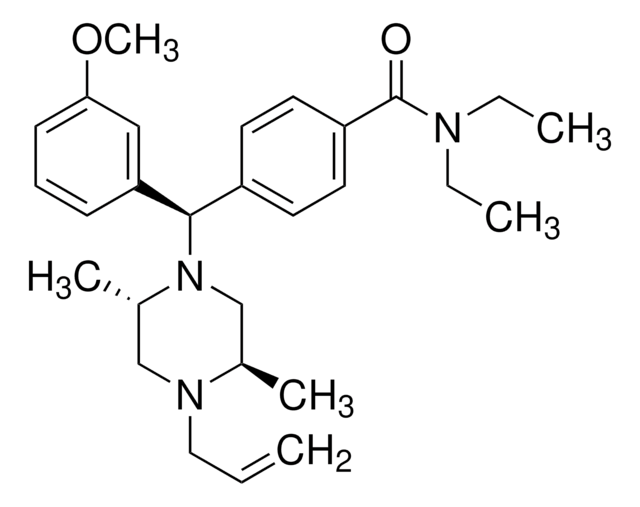E7384
[D-Ala2, N-Me-Phe4, Gly5-ol]-Enkephalin acetate salt
≥97% (HPLC)
Synonyme(s) :
DAGO, DAMGO, Tyr-D-Ala-Gly-N-methyl-Phe-Gly-ol
About This Item
Produits recommandés
Pureté
≥97% (HPLC)
Température de stockage
−20°C
Chaîne SMILES
CC(O)=O.C[C@@H](NC(=O)[C@@H](N)Cc1ccc(O)cc1)C(=O)NCC(=O)N(C)[C@@H](Cc2ccccc2)C(=O)NCCO
InChI
1S/C26H35N5O6.C2H4O2/c1-17(30-25(36)21(27)14-19-8-10-20(33)11-9-19)24(35)29-16-23(34)31(2)22(26(37)28-12-13-32)15-18-6-4-3-5-7-18;1-2(3)4/h3-11,17,21-22,32-33H,12-16,27H2,1-2H3,(H,28,37)(H,29,35)(H,30,36);1H3,(H,3,4)/t17-,21+,22+;/m1./s1
Clé InChI
XZZYKCKUDLGXJA-NJUGUJQKSA-N
Informations sur le gène
human ... OPRM1(4988)
mouse ... OPRM1(18390)
rat ... OPRM1(25601)
Vous recherchez des produits similaires ? Visite Guide de comparaison des produits
Amino Acid Sequence
Description générale
Application
- for use as a positive control in the assay of G-protein activation with μ-opioid receptor, to assay the inhibition of cAMP inhibition by DAMGO
- for the determination of the suppression of contraction by opioid receptors
- to determine whether the peripheral application of DAMGO suppresses the hypertonic saline (HS)-induced masseter nociception in slightly anaesthetized rats
Actions biochimiques/physiologiques
Conditionnement
Code de la classe de stockage
11 - Combustible Solids
Classe de danger pour l'eau (WGK)
WGK 3
Point d'éclair (°F)
Not applicable
Point d'éclair (°C)
Not applicable
Équipement de protection individuelle
Eyeshields, Gloves, type N95 (US)
Certificats d'analyse (COA)
Recherchez un Certificats d'analyse (COA) en saisissant le numéro de lot du produit. Les numéros de lot figurent sur l'étiquette du produit après les mots "Lot" ou "Batch".
Déjà en possession de ce produit ?
Retrouvez la documentation relative aux produits que vous avez récemment achetés dans la Bibliothèque de documents.
Les clients ont également consulté
Notre équipe de scientifiques dispose d'une expérience dans tous les secteurs de la recherche, notamment en sciences de la vie, science des matériaux, synthèse chimique, chromatographie, analyse et dans de nombreux autres domaines..
Contacter notre Service technique




![[D-Ala2, D-Leu5]-Enkephalin acetate salt ≥95% (HPLC)](/deepweb/assets/sigmaaldrich/product/structures/934/176/d990e568-42df-43e9-a231-da7a3d9d7687/640/d990e568-42df-43e9-a231-da7a3d9d7687.png)
![[D-Pen2,5]-Enkephalin hydrate ≥95% (HPLC)](/deepweb/assets/sigmaaldrich/product/structures/184/136/1e0e1352-7665-406c-b51c-9a4fd9474b9a/640/1e0e1352-7665-406c-b51c-9a4fd9474b9a.png)


![[D-Ala2]-Leucine enkephalin ≥97% (HPLC)](/deepweb/assets/sigmaaldrich/product/structures/205/481/4fd123c0-14c7-4f90-8bdc-9e54a4bea7f1/640/4fd123c0-14c7-4f90-8bdc-9e54a4bea7f1.png)


